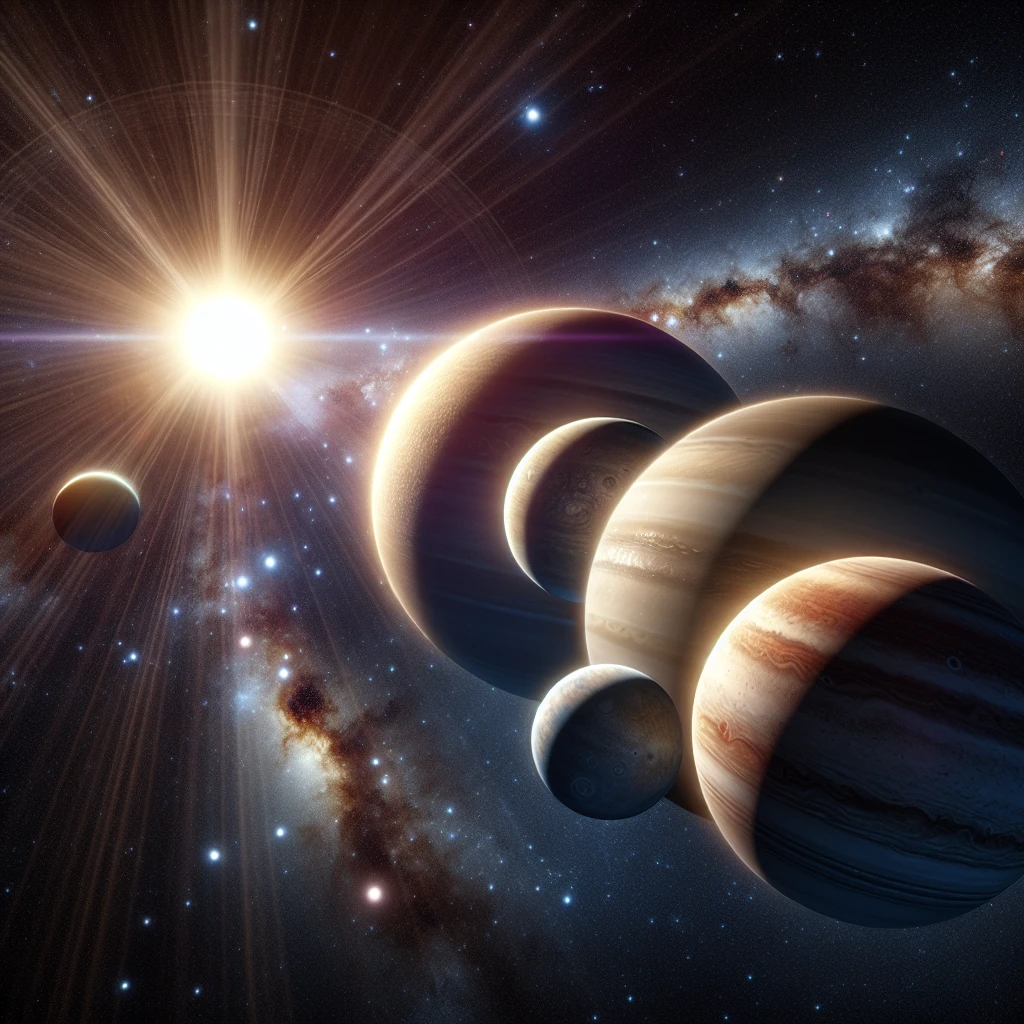Scientists have found a “perfect solar system” that is great for studying how planets are formed and if they can support life. This system is called HD110067 and it is located 100 light years away. It has six planets that are all about the same size and have been the same for a really long time, like 12 billion years. Our own solar system is different because our planets were made through big crashes, so they are different sizes. The planets in HD110067 all move together and have a special pattern of how fast they go around. Scientists even made a song based on how the planets move!
Dr Rafael Luque, who led the research, said that HD110067 is “the perfect solar system” because it didn’t start out in a crazy way like ours did. Dr Marina Lafarga-Magro said that the system is “beautiful and unique” and it’s cool to see something that no one has seen before. Astronomers are really interested in this system because it hasn’t been messed up and the planets are all the same size. This makes it easier to study how planets are made and change. Also, the system has a bright star, which makes it easier to look for signs of life on the planets.
All of the planets in this system are called “sub-Neptunes.” They are bigger than Earth but smaller than Neptune. These kinds of planets are thought to be the most common in the galaxy, but scientists don’t know much about them. Finding HD110067 gives scientists a chance to learn more about these planets and if they can have life. If the next observations show that sub-Neptunes can have life, it means there’s a better chance of finding life on other planets.
Scientists are now trying to find signs of life on one of the six new sub-Neptunes or on other similar planets found by different groups. With better telescopes and new technology, many scientists think that finding life on other planets might not take too long. The planets in HD110067 were found using NASA’s Transiting Exoplanet Survey Satellite (TESS) and ESA’s CHaracterising ExOPlanet Satellite (Cheops).
Original news source: Perfect solar system’ found in search for alien life (BBC)
Listen
Slow
Normal
Fast
Group or Classroom Activities
Warm-up Activities:
– News Summary
Instructions:
1. In pairs, read the article silently.
2. Take turns summarizing the main points of the article to your partner.
3. Try to include important details and key information in your summary.
4. Switch roles and repeat the process.
– Opinion Poll
Instructions:
1. In small groups, discuss your opinions about the article.
2. Each person should share their thoughts and reasons for their opinions.
3. Take turns asking each other questions about the article and respond with your opinions.
4. Try to engage in a respectful and meaningful discussion.
– Vocabulary Pictionary
Instructions:
1. Choose 10-15 vocabulary words from the article.
2. Divide the class into pairs or small groups.
3. One person from each group will choose a word and draw a picture to represent it.
4. The other members of the group will try to guess the word based on the drawing.
5. Rotate roles until all the words have been guessed.
– Speed Summarizing
Instructions:
1. Divide the class into pairs.
2. Give each pair a set amount of time (e.g. 2 minutes) to summarize the article together.
3. Encourage them to include the main points and key details in their summary.
4. After the time is up, have pairs switch partners and summarize the article again.
5. Repeat the process several times, gradually reducing the time limit.
– Think-Pair-Share
Instructions:
1. Read the article individually.
2. Think about the main idea and any questions or thoughts that come to mind.
3. Pair up with a partner and take turns sharing your thoughts and questions.
4. Listen actively to your partner and ask follow-up questions or provide feedback.
5. After both partners have shared, open up the discussion to the whole class and share some of the interesting points that came up during the activity.
Comprehension Questions:
1. What makes HD110067 a “perfect solar system” for studying planet formation and the possibility of life?
2. How is the HD110067 solar system different from our own solar system?
3. What is the special pattern of movement that the planets in HD110067 have?
4. Why are astronomers interested in studying the HD110067 system?
5. What are the planets in HD110067 called and how do they compare in size to Earth and Neptune?
6. Why is finding HD110067 significant for scientists?
7. What are scientists hoping to find on one of the sub-Neptunes in the HD110067 system?
8. What technology was used to discover the planets in the HD110067 system?
Go to answers ⇩
Listen and Fill in the Gaps:
Scientists have (1)______ a “perfect solar system” that is great for studying how planets are formed and if they can (2)______ life. This system is called HD110067 and it is located 100 light (3)______ away. It has six planets that are all about the same size and have been the same for a really long time, like 12 billion years. Our own solar system is (4)______ because our planets were made through big crashes, so they are different sizes. The planets in HD110067 all move together and have a special pattern of how fast they go around. (5)______ even made a song based on how the planets move!
Dr Rafael Luque, who led the research, said that (6)______ is “the perfect solar (7)______” because it didn’t start out in a (8)______ way like ours did. Dr Marina Lafarga-Magro said that the system is “beautiful and unique” and it’s cool to see something that no one has seen before. Astronomers are really interested in this system because it hasn’t been messed up and the planets are all the same size. This makes it easier to study how planets are made and change. Also, the system has a bright star, which makes it easier to look for signs of life on the planets.
All of the planets in this system are called “sub-(9)______s.” They are bigger than (10)______ but smaller than Neptune. These kinds of planets are thought to be the most (11)______ in the galaxy, but scientists don’t know much about them. Finding HD110067 gives scientists a chance to learn more about these planets and if they can have life. If the next (12)______ show that sub-Neptunes can have life, it means there’s a better (13)______ of finding life on other planets.
Scientists are now (14)______ to find signs of life on one of the six new sub-Neptunes or on other (15)______ planets found by different groups. With better telescopes and new technology, many scientists (16)______ that finding life on other planets might not take too long. The planets in HD110067 were found using NASA’s Transiting Exoplanet Survey Satellite (TESS) and ESA’s CHaracterising ExOPlanet Satellite (Cheops).
Go to answers ⇩
Discussion Questions:
Students can ask a partner these questions, or discuss them as a group.
1. What is a solar system?
2. How would you feel if you discovered a new solar system?
3. Do you think it’s important for scientists to study how planets are formed? Why or why not?
4. What do you think makes HD110067 a “perfect solar system”?
5. How do you think the planets in HD110067 moving together is different from our own solar system?
6. Do you like the idea of scientists making a song based on how the planets move? Why or why not?
7. What do you think it means for a solar system to start out in a “crazy way”?
8. How do you think having a bright star in the system makes it easier to look for signs of life on the planets?
9. What do you think it would be like to live on a sub-Neptune planet?
10. Do you think it’s important for scientists to learn more about sub-Neptunes? Why or why not?
11. How do you think finding signs of life on one of the sub-Neptunes would change our understanding of life in the universe?
12. Do you think it’s possible to find life on other planets? Why or why not?
13. How do you think better telescopes and new technology can help in the search for life on other planets?
14. What do you think are some challenges scientists might face in their search for life on other planets?
15. How do you think the discovery of HD110067 and other similar planets will impact future space exploration?
Individual Activities
Vocabulary Meanings:
Match each word to its meaning.
Words:
1. solar system
2. planets
3. support
4. formed
5. crashes
6. pattern
7. astronomers
8. telescopes
Meanings:
(a) Created or shaped
(b) Devices used to observe distant objects in space
(c) A group of planets that orbit a star
(d) Violent collisions
(e) Help or sustain
(f) Celestial bodies that orbit a star
(g) Scientists who study celestial objects
(h) A specific arrangement or design
Go to answers ⇩
Multiple Choice Questions:
1. What is the name of the solar system that scientists have found?
(a) HD110066
(b) HD110068
(c) HD110069
(d) HD110067
2. How far away is the solar system from Earth?
(a) 50 light years
(b) 200 light years
(c) 100 light years
(d) 500 light years
3. How many planets are there in the HD110067 solar system?
(a) Five
(b) Seven
(c) Six
(d) Eight
4. How long have the planets in HD110067 been the same size?
(a) 10 billion years
(b) 15 billion years
(c) 8 billion years
(d) 12 billion years
5. What is special about the way the planets in HD110067 move?
(a) They move at different speeds
(b) They all move together
(c) They move in random patterns
(d) They move in opposite directions
6. What kind of star does the HD110067 solar system have?
(a) Bright star
(b) Dim star
(c) Medium star
(d) No star
7. What are the planets in HD110067 called?
(a) Super-Earths
(b) Sub-Neptunes
(c) Mini-Jupiters
(d) Mega-Mars
8. How were the planets in HD110067 found?
(a) Using NASA’s TESS and ESA’s Cheops
(b) Using Hubble Space Telescope
(c) Using the International Space Station
(d) Using a ground-based telescope
Go to answers ⇩
True or False Questions:
1. Unlike our solar system, which formed through collisions, the planets in HD110067 have a uniform size and move together in a unique pattern.
2. The solar system has six planets that are all different sizes and have changed significantly in the past 12 billion years.
3. Dr Rafael Luque, the lead researcher, describes HD110067 as “an imperfect solar system” due to its unstable formation.
4. Scientists have even created a song based on the movement of the planets in HD110067.
5. Scientists have discovered a solar system called HD110067 that is ideal for studying planet formation and the potential for supporting life.
6. Astronomers are particularly interested in this system because it provides an opportunity to study planet formation and changes without interference.
7. The absence of a bright star in HD110067 makes it easier for scientists to search for signs of life on the planets.
8. HD110067 is located 10 light years away from Earth.
Go to answers ⇩
Write a Summary:
Write a summary of this news article in two sentences.
Check your writing now with the best free AI for English writing!
Writing Questions:
Answer the following questions. Write as much as you can for each answer.
Check your answers with our free English writing assistant!
1. What makes the solar system HD110067 unique and interesting to scientists?
2. How are the planets in HD110067 different from the planets in our own solar system?
3. What are sub-Neptunes and why are scientists interested in studying them?
4. How were the planets in HD110067 discovered?
5. What are scientists hoping to find on the planets in HD110067 and other similar planets?
Answers
Comprehension Question Answers:
1. HD110067 is considered a “perfect solar system” for studying planet formation and the possibility of life because it has six planets that are all about the same size and have remained stable for a long time. This allows scientists to study how planets are formed and how they change over time. Additionally, the system has a bright star, which makes it easier to search for signs of life on the planets.
Answer: HD110067 is a “perfect solar system” for studying planet formation and the possibility of life because it has six planets that are all about the same size and have remained stable for a long time. Additionally, the system has a bright star, which makes it easier to search for signs of life on the planets.
2. The HD110067 solar system is different from our own solar system because our planets were formed through large collisions, resulting in planets of different sizes. In contrast, the planets in HD110067 have all remained the same size for billions of years.
Answer: The HD110067 solar system is different from our own solar system because our planets were formed through large collisions, resulting in planets of different sizes. In contrast, the planets in HD110067 have all remained the same size for billions of years.
3. The planets in HD110067 have a special pattern of movement where they all move together and orbit the star at specific speeds.
Answer: The planets in HD110067 have a special pattern of movement where they all move together and orbit the star at specific speeds.
4. Astronomers are interested in studying the HD110067 system because it provides an opportunity to study planet formation and change in a system that hasn’t been disrupted. The planets in this system are all the same size, making it easier to study their characteristics. Additionally, the system has a bright star, which makes it easier to search for signs of life on the planets.
Answer: Astronomers are interested in studying the HD110067 system because it provides an opportunity to study planet formation and change in a system that hasn’t been disrupted. The planets in this system are all the same size, making it easier to study their characteristics. Additionally, the system has a bright star, which makes it easier to search for signs of life on the planets.
5. The planets in HD110067 are called “sub-Neptunes.” They are bigger than Earth but smaller than Neptune.
Answer: The planets in HD110067 are called “sub-Neptunes.” They are bigger than Earth but smaller than Neptune.
6. Finding HD110067 is significant for scientists because it allows them to learn more about sub-Neptunes, which are believed to be the most common type of planet in the galaxy. By studying these planets and their potential for life, scientists can gain insights into the possibility of finding life on other planets.
Answer: Finding HD110067 is significant for scientists because it allows them to learn more about sub-Neptunes, which are believed to be the most common type of planet in the galaxy. By studying these planets and their potential for life, scientists can gain insights into the possibility of finding life on other planets.
7. Scientists are hoping to find signs of life on one of the sub-Neptunes in the HD110067 system or on other similar planets discovered by different groups.
Answer: Scientists are hoping to find signs of life on one of the sub-Neptunes in the HD110067 system or on other similar planets discovered by different groups.
8. The planets in the HD110067 system were discovered using NASA’s Transiting Exoplanet Survey Satellite (TESS) and ESA’s CHaracterising ExOPlanet Satellite (Cheops).
Answer: The planets in the HD110067 system were discovered using NASA’s Transiting Exoplanet Survey Satellite (TESS) and ESA’s CHaracterising ExOPlanet Satellite (Cheops).
Go back to questions ⇧
Listen and Fill in the Gaps Answers:
(1) found
(2) support
(3) years
(4) different
(5) Scientists
(6) HD110067
(7) system
(8) crazy
(9) Neptune
(10) Earth
(11) common
(12) observations
(13) chance
(14) trying
(15) similar
(16) think
Go back to questions ⇧
Vocabulary Meanings Answers:
1. solar system
Answer: (c) A group of planets that orbit a star
2. planets
Answer: (f) Celestial bodies that orbit a star
3. support
Answer: (e) Help or sustain
4. formed
Answer: (a) Created or shaped
5. crashes
Answer: (d) Violent collisions
6. pattern
Answer: (h) A specific arrangement or design
7. astronomers
Answer: (g) Scientists who study celestial objects
8. telescopes
Answer: (b) Devices used to observe distant objects in space
Go back to questions ⇧
Multiple Choice Answers:
1. What is the name of the solar system that scientists have found?
Answer: (d) HD110067
2. How far away is the solar system from Earth?
Answer: (c) 100 light years
3. How many planets are there in the HD110067 solar system?
Answer: (c) Six
4. How long have the planets in HD110067 been the same size?
Answer: (d) 12 billion years
5. What is special about the way the planets in HD110067 move?
Answer: (b) They all move together
6. What kind of star does the HD110067 solar system have?
Answer: (a) Bright star
7. What are the planets in HD110067 called?
Answer: (b) Sub-Neptunes
8. How were the planets in HD110067 found?
Answer: (a) Using NASA’s TESS and ESA’s Cheops
Go back to questions ⇧
True or False Answers:
1. Unlike our solar system, which formed through collisions, the planets in HD110067 have a uniform size and move together in a unique pattern. (Answer: True)
2. The solar system has six planets that are all different sizes and have changed significantly in the past 12 billion years. (Answer: False)
3. Dr Rafael Luque, the lead researcher, describes HD110067 as “an imperfect solar system” due to its unstable formation. (Answer: False)
4. Scientists have even created a song based on the movement of the planets in HD110067. (Answer: True)
5. Scientists have discovered a solar system called HD110067 that is ideal for studying planet formation and the potential for supporting life. (Answer: True)
6. Astronomers are particularly interested in this system because it provides an opportunity to study planet formation and changes without interference. (Answer: True)
7. The absence of a bright star in HD110067 makes it easier for scientists to search for signs of life on the planets. (Answer: False)
8. HD110067 is located 10 light years away from Earth. (Answer: False)
Go back to questions ⇧













